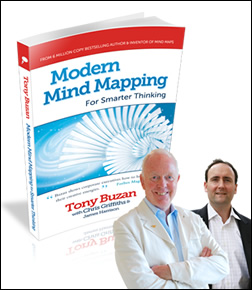#8 in the Effective Mind Maps blog post series
Basic ordering ideas are the first-level topics that radiate out from your map’s central topic. They are the key concepts that help you to produce the greatest number of associations as you develop and organize your thoughts. If your first-level topics are well thought out, then the rest of the mind map should be of excellent quality as well.
This concept was originally developed by Tony Buzan as part of his mind mapping methodology, and has been ignored by most developers of mind mapping software. But the idea behind basic ordering ideas (or BOIs) is a solid one, and you can almost certainly improve the quality of your mind maps by being aware of how to create good first-level topics.
In The Mind Map Book, written by Tony and Barry Buzan, the authors provide the clearest explanation of what BOIs are and why they’re so important. The authors believe that creating effective basic ordering entries is a critical first step when creating a mind map, because they shape the content and meaning of the rest of the map:
“Basic ordering ideas are key concepts within which a host of other concepts can be organized… these power words or basic ordering ideas are the key to shaping and steering the creative process of association. To put it another way, they are the chapter headings you would use if you were writing a book on the subject.”
“Basic ordering ideas help to shape, sculpt and construct mind maps enabling the mind to think in a naturally structured way… the primary ideas are in place so that secondary and tertiary ideas can follow quickly and easily to facilitate a harmonious thought structure.”
 In their latest book, Modern Mind Mapping for Smart Thinking, Tony Buzan and Chris Griffiths explain how most people view mind maps as an “unstructured” form of visual thinking. But actually, nothing could be farther from the truth:
In their latest book, Modern Mind Mapping for Smart Thinking, Tony Buzan and Chris Griffiths explain how most people view mind maps as an “unstructured” form of visual thinking. But actually, nothing could be farther from the truth:
“Contrary to what some people believe, Mind Mapping is not ‘unstructured thinking’. In fact, it’s one of the most structured forms of thinking possible… The central theme, in particular, keeps you focused on your main goal while still allowing you to think freely and expansively as you work around it. What this means is that you can be as generative as you like – letting your thoughts range far and wide – but you can refer back to your central theme at any point so that you don’t go astray from your task. Essentially the Mind Map stops you ‘shooting from the hip’ as you always have a clear view of your target.”
An example of basic ordering ideas in action
Imagine that you’re preparing a major business proposal or writing a book. You would want to create section or chapter headings that are meaningful, relevant and easy for your reader or target audience to follow, correct? Further, you would want these major headings, taken together, to provide an accurate, high-level overview of the topic, wouldn’t you?
That’s what basic ordering ideas are all about – creating three to seven major “hooks” that fully describe your map’s topic at a high level and which serve as a mental catalyst to drive the rest of your brainstorming and mental mapping processes.
What does this mean? if you don’t pay adequate attention to your BOIs, then you will probably end up with a poorly organized, hard-to-understand mind map. Of course, this is more critical for a hand-written map where you’re stuck with your major topics wherever you wrote them on the page. Mind mapping software allows you to add, delete or edit your map’s topics at any time. Still, I think this is an important principle that you ought to be mindful of. Understanding and applying this concept to each mind map you create will ultimately make you a better visual mapper!
(originally published Dec. 8, 2008. Updated to be included in the Effective Blog Posts series Jan. 10, 2013)


Leave a Reply